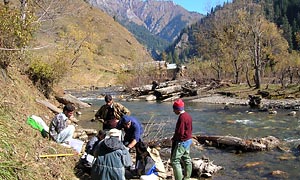Investigating Predator Prey Interactions in Scofield Reservoir, UT.
Date:
2011-2014
Abstract:
Aquatic food webs are controlled by complex spatial and temporal interactions within and among trophic levels. The strength of interactions within the community may determine processes that regulate populations in the food web. Scofield Reservoir currently contains Utah chub, and is stocked with three top predators (rainbow trout, Bonneville cutthroat trout, and tiger trout), with unknown potential for competition for food and/or space. In order to design a greater study examining predator prey dynamics and interspecific interactions, we performed a pilot study during summer 2011 to comprehensively survey the fish community and limnology of Scofield Reservoir. From this pilot work, we identified several hypotheses of predator-prey and interspecific interactions. We will use bioenergetics modeling as a tool to explicitly consider the mechanisms that operate to structure populations and food webs and thus quantify predatory control of forage. We will also implement a controlled experiment through selectively stocking trout in ponds to examine multi-species competitive interactions. The results of this study will assist managers in establishing a more biologically efficient stocking program, by better understanding the factors limiting top predator fish growth and performance.
Funding:
- Utah Division of Wildlife Resources
- US Geological Survey – Utah Cooperative Fish and Wildlife Unit (in-kind)
Investigators:
- Phaedra Budy, Principal Investigator, US Geological Survey–UCFWRU, USU Dept. of Watershed Sciences
- Gary P. Thiede, Fishery Biologist, USU Dept. of Watershed Sciences
- Lisa Winters, Graduate Research Assistant (M.S.), USU Dept. of Watershed Sciences (expected graduation, Spring 2013)




